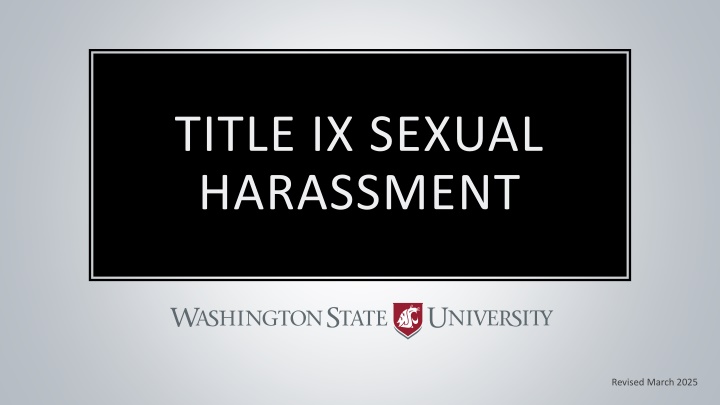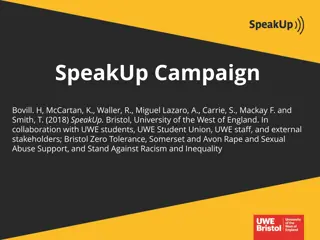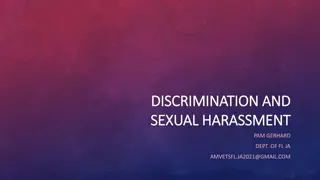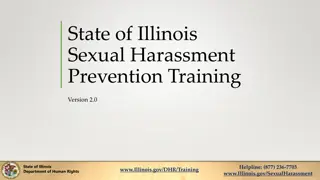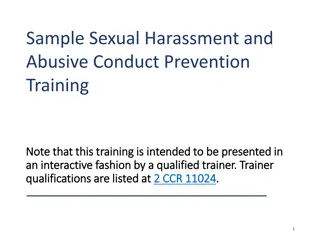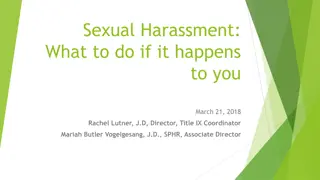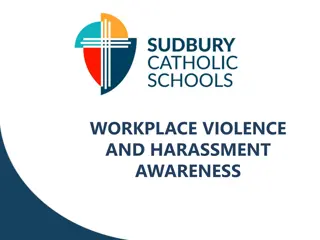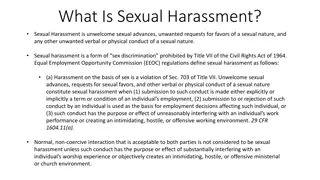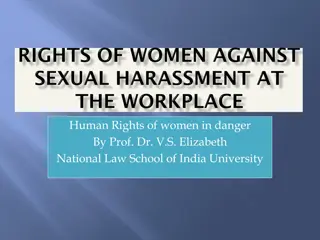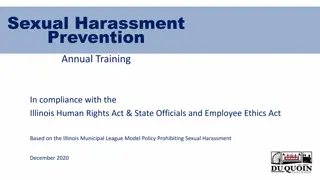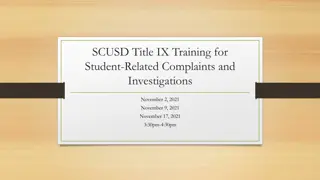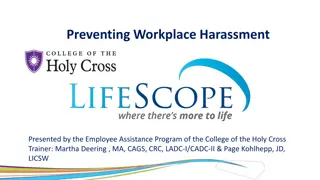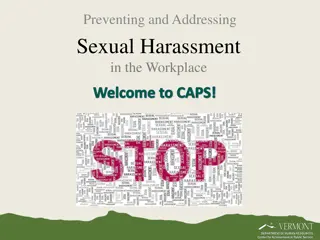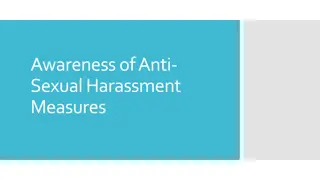Title IX Sexual Harassment - Revised March 2025
"Overview of Title IX Sexual Harassment policies, definitions, processes, and prohibited behaviors. Includes information on Quid Pro Quo Harassment, Sexual Assault, and more. Ensuring equal access to education and programs."
Download Presentation

Please find below an Image/Link to download the presentation.
The content on the website is provided AS IS for your information and personal use only. It may not be sold, licensed, or shared on other websites without obtaining consent from the author.If you encounter any issues during the download, it is possible that the publisher has removed the file from their server.
You are allowed to download the files provided on this website for personal or commercial use, subject to the condition that they are used lawfully. All files are the property of their respective owners.
The content on the website is provided AS IS for your information and personal use only. It may not be sold, licensed, or shared on other websites without obtaining consent from the author.
E N D
Presentation Transcript
TITLE IX SEXUAL HARASSMENT Revised March 2025
Title IX Sexual Harassment definitions Title IX Jurisdiction Reports and Formal Complaints Informal Resolution Process Investigation Process Hearing Process Appeals Process Serving Impartially and Neutrally Assessing Evidence COURSE OBJECTIVES
EP 15 = WSU Policy Prohibiting Discrimination and Harassment CCR = Compliance & Civil Rights CCS = Center for Community Standards HRS = Human Resource Services COURSE LANGUAGE
WSU Policy Prohibiting Discrimination and Harassment, Executive Policy (EP 15) prohibits Title IX Sexual Harassment. SEXUAL HARASSMENT (1)
TITLE IX SEXUAL HARASSMENT (2) Title IX Sexual Harassment Quid Pro Quo Harassment Sexual Assault Dating Violence Domestic Violence Stalking
SEXUAL HARASSMENT (2) Unwelcome conduct Determined by a reasonable person to be so severe, pervasive, and objectively offensive That it effectively denies a person equal access to the university s education, program or activity
QUID PRO QUO HARASSMENT An employee or other person over whom WSU has disciplinary authority Explicitly or impliedly conditioning the provision of an aid, benefit, or service Upon a person s participation in unwelcome sexual conduct
SEXUAL ASSAULT Sexual Assault includes forcible or nonforcible sex offenses under the uniform crime reporting system of the Federal Bureau of Investigation, including: Sex offense Rape Sodomy Sexual assault with an object Fondling Incest Statutory Rape
CONSENT (1) Consent: Must be clear, knowing, and voluntary Requires all parties to: Actively express words or conduct That a reasonable person would conclude demonstrates clear permission
CONSENT (2) Sexual activity is also nonconsensual where: Force or coercion is used Physical violence, force, threat, or intimidation Unreasonable pressure for sexual activity Person is: asleep, unconscious, or physically unable to communicate their unwillingness to engage in sexual activity Person lacks the mental capacity to consent, through illness, defect, the influence of alcohol or some other substance, or some other cause
Any sexual act directed against another person, without the consent of the victim, including instances where the victim is incapable of giving consent. SEX OFFENSE
Penetration, no matter how slight, of the vagina or anus with any body part or object, or oral penetration by a sex organ of another person, or by a sex-related object, without the consent of the victim Includes instances where the victim is incapable of giving consent because of their age or because of their temporary or permanent mental or physical incapacity. RAPE
Oral or anal sexual intercourse with another person, without the consent of the victim. Includes instances where the victim is incapable of giving consent because of their age or because of their temporary or permanent mental or physical incapacity. SODOMY
To use an object or instrument to unlawfully penetrate, however, slightly, the genital or anal opening of the body of another person, without the consent of the victim, including instances where the victim is incapable of giving consent because of their age or because of their temporary or permanent mental or physical incapacity. SEXUAL ASSAULT WITH AN OBJECT
The touching of the private body parts of another person for the purpose of sexual gratification, without the consent of the victim Includes instances where the victim is incapable of giving consent because of their age or because of their temporary or permanent mental or physical incapacity FONDLING
Sexual intercourse between persons who are related to each other within the degrees wherein marriage is prohibited by law RCW 26.04.20: Marriage prohibitions Nearer of kin to each other than second cousins Sibling Child Grandchild Aunt Uncle Niece Nephew INCEST
Sexual intercourse with a person who is under the statutory age of consent. Washington state age of consent: RCW 9A.44: 16 years old STATUTORY RAPE
DATING VIOLENCE Violence committed by a person who is or has been in a social relationship of a romantic or intimate nature with the victim. Relationship: Determined based on the length of the relationship, the type of relationship, and the frequency of interaction between the persons involved in the relationship.
DOMESTIC VIOLENCE A felony or misdemeanor crime of violence committed: By a current or former spouse or intimate partner of the victim By a person with whom the victim shares a child in common By a person who is cohabitating with, or has cohabitated with, the victim as a spouse or intimate partner By a person similarly situated to a spouse of the victim under the domestic or family violence laws of Washington, or By any other person against an adult or youth victim who is protected from that person s act under the domestic or family violence laws of Washington. Washington state domestic violence: RCW 10.99.20
STALKING (1) Engaging in a course of conduct directed at a specific person that would cause a reasonable person to: Fear for the person s safety or the safety of others Suffer substantial emotional distress
STALKING (2) Course of conduct means: Two or more acts, including, but not limited to, acts in which the stalker directly, indirectly, or through third parties, by any action, method, device, or means, follows, monitors, observes, or interferes with a person s property. Reasonable person means: A reasonable person under similar circumstances and with similar identities to the victim Substantial emotional distress means: Significant mental suffering or anguish that may, but does not necessarily, require medical or other professional treatment or counseling
JURISDICTION Refers to the specific circumstances or locations that WSU can exercise control over. Under Title IX, it must meet both: Title IX Jurisdiction definition and Title IX Sexual Harassment definitions. If not, it is not Title IX conduct. May still address under other university policies.
TITLE IX JURISDICTION (2) Applies to students, faculty, staff, and others having an association with WSU where the alleged incident(s): 1. Could constitute Title IX Sexual Harassment 2. Occurred within WSU s educational program or activity 3. Occurred against a person in the US 4. Occurred against a person who is participating in or attempting to participate in WSU s educational program or activity
TITLE IX JURISDICTION (3) Educational program or activity includes: 1. Locations, events, or circumstances over which WSU exercises substantial control over both the respondent and the context in which the sexual harassment occurred 2. Any building owned or controlled by a student organization that is officially recognized
Educational program or activity could include: On campus programs or activities Off campus programs or activities (located in the US) where WSU also exercises substantial control over the respondent Residence Halls Houses owned by fraternities or sororities who are officially recognized PROGRAMS OR ACTIVITIES
EXAMPLE #1 Student A sexually assaults another student at an off-campus apartment. WSU does not exercise any control of the off-campus apartment. This conduct is not Title IX Sexual Harassment because although the conduct would constitute Title IX Sexual Harassment, the conduct did not occur within WSU s educational program or activity. Even though it is not Title IX Sexual Harassment, it could still be addressed under other provisions of EP 15.
EXAMPLE #2 During an advising session, a WSU employee informs a student that they will only ensure the student receives a scholarship if the student agrees to have sex with them. This conduct is Title IX Sexual Harassment because the conduct would constitute Title IX Sexual Harassment, it occurred within WSU s educational program or activity, WSU exercises substantial control over the employee, it occurred against a person in the US, and it occurred against a person who was participating in WSU s educational programs or activities.
EXAMPLE #3 On campus, prior to class, Student A tells Student B that they d like to Netflix and chill with them, a reference to sex. This makes Student B uncomfortable. This conduct is not Title IX Sexual Harassment because although it occurred within WSU s educational program or activity, occurred against a person in the US, and occurred against a person who was participating in WSU s educational programs or activities, the conduct does not rise to the level of Title IX Sexual Harassment, because it is not so severe, pervasive, and objectively offensive that it effectively denies a person equal access to the university s education program or activity.
REPORTS AND FORMAL COMPLAINTS (2) Individuals can share information with the Title IX Coordinator or CCR for two different purposes: Reporting Formal Complaint
Can be made 24/7 via online reporting form, via email, or telephone Can be made by any person (e.g. the person who experienced the misconduct (the Complainant) or a person who knows about misconduct) Triggers a response from WSU to the Complainant and/or Reporter REPORTS (1)
CCR will reach out to the Complainant and/or Reporter with information on: Supportive measures (including that these are available with or without filing a formal complaint) Grievance processes How to file a complaint Statement that the Complainant s wishes with respect to supportive measures will be considered WSU S RESPONSE TO A REPORT
Reports can be made for the purpose of: Documenting concerns Facilitating supportive measures or resources REPORTS (2) Requesting a consultation To learn about filing a Formal Complaint
SUPPORTIVE MEASURES Non-disciplinary, non-punitive individualized services offered as appropriate and as reasonably available, without fee or charge to complainant or respondent. Can include: Academic support Medical or counseling resources or referrals Referrals to external resources (e.g. victim advocacy agency) Safety planning/ workplace management plans Adjustments to academic or work schedules No contact directives Additional options are listed in EP 15.
FORMAL COMPLAINTS A formal complaint can be filed for the purpose of seeking an: 1. Informal Resolution or 2. Investigation. Supportive Measures are also available for individuals filing a Formal Complaint
Formal Complaints: Can be made 24/7 to CCR Formal Complaint form must be filled out and signed by: The Complainant Title IX Coordinator or designee FILING A FORMAL COMPLAINT The Complainant should indicate their preferred resolution: Informal Resolution Formal Investigation
CCR will determine if the Formal Complaint may be Title IX Sexual Harassment and within the Title IX jurisdiction. If so, CCR may initiate an investigation or informal resolution. If not, CCR is required to dismiss the complaint under Title IX provisions but may proceed under other provisions of EP 15. May include an investigation or informal resolution under other EP 15 provisions. FORMAL COMPLAINT ASSESSMENT (1)
CCR may also dismiss the formal complaint if: 1. CCR is unable to identify the respondent after taking reasonable steps to do so; 2. The respondent is not currently participating in WSU s education program or activity and is not employed by WSU, or was not at the time of the alleged incident(s); 3. The complainant voluntarily withdraws any or all of the allegations in their complaint, and any remaining conduct does not constitute an EP 15 violation; FORMAL COMPLAINT ASSESSMENT (2) 4. The parties voluntarily resolved their matter through an Informal Resolution; or Specific circumstances prevent an investigator from gathering evidence sufficient to make a determination. 5.
EXAMPLE #4 Employee A contacts CCR and states that Employee B said Employee C was sexually harassing her. Employee A files a formal complaint and requests an investigation. What happens? The formal complaint must be filled out by the actual complainant, Employee B, or by the Title IX Coordinator. Employee A s statement to CCR will be treated as a report. CCR will reach out to Employee B with information about supportive measures and how to file a formal complaint. Depending on the information received, the Title IX Coordinator may also file a complaint to initiate an investigation or informal resolution.
EXAMPLE #5 Student A reports to CCR that Student B sexually assaulted them. Student A does not want an investigation but wants help with academic resources. What happens? In most circumstances, CCR will respect Student A s request not to investigate and help Student A with academic resources. Under certain circumstances, the Title IX Coordinator may file a formal complaint and initiate an investigation, particularly if there are ongoing safety concerns for the WSU community.
INFORMAL RESOLUTION (1) Informal Resolutions are different than supportive measures because they: May have provisions that apply to both parties Require formal notice to both parties Require voluntary, signed consent from both parties to engage in the process Informal resolutions are not available to resolve allegations that an employee sexually harassed a student, as defined by the Title IX Violation/Jurisdiction in EP 15.
Conduct management plans or resolution agreements; Verbal or written counseling; Departmental resolutions; Alternative dispute resolutions; Mediation, if available; and/or Additional required training. INFORMAL RESOLUTION (2) Informal Resolutions may include measures deemed punitive towards the Respondent.
Complainant files a formal complaint requesting an informal resolution. CCR reviews the formal complaint and confirms the conduct implicates EP 15 and is appropriate for an informal resolution. CCR sends Notice of Informal Resolution to the Complainant and the Respondent. INFORMAL RESOLUTION PROCESS
Summary of allegations Information on EP 15 and CCR Procedures Parties will have sufficient time to prepare Parties may have advisor of their choice Prohibition on retaliation and interference Prohibition on making a false statement or submitting false information Information on Supportive Measures Limitations on confidentiality INFORMAL RESOLUTION NOTICE (1)
Participation is voluntary May involve provisions designed to punish the Respondent Respondent is presumed not responsible Requirements of process Either party may withdraw from the Informal Resolution process and resume the grievance process, at any point prior to an agreed upon resolution (once agreed upon, the resolution is binding) Request for both parties to provide voluntary, written consent INFORMAL RESOLUTION NOTICE (2)
Facilitator will work with both parties to arrive to an agreed upon resolution. When the parties are satisfied with the provisions of the resolution, the Facilitator will request their signature on a binding agreement. If parties cannot agree to a resolution, the parties will be informed of their right to resume the grievance process with regards to a Formal Complaint. INFORMAL RESOLUTION FACILITATION
EXAMPLE #6 Student A files a formal complaint with CCR alleging that Employee B sexually harassed Student A. Student A requests an informal resolution. What happens? CCR will review the allegations. If the allegations constitute Title IX Sexual Harassment, CCR cannot proceed with an informal resolution, because per EP 15, Informal Resolutions are not available for matters involving employees sexually harassing students under Title IX. However, if the allegations do not rise to the level of a Title IX Sexual Harassment complaint, CCR could proceed with an informal resolution under other EP 15 provisions.
